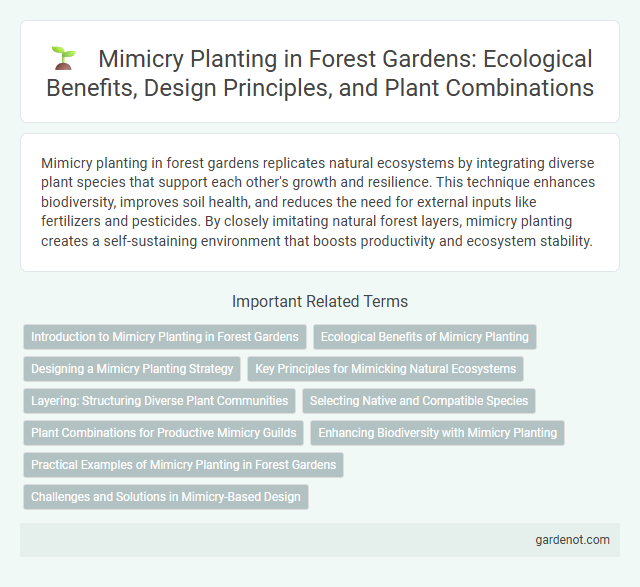Mimicry planting in forest gardens replicates natural ecosystems by integrating diverse plant species that support each other's growth and resilience. This technique enhances biodiversity, improves soil health, and reduces the need for external inputs like fertilizers and pesticides. By closely imitating natural forest layers, mimicry planting creates a self-sustaining environment that boosts productivity and ecosystem stability.
Introduction to Mimicry Planting in Forest Gardens
Mimicry planting in forest gardens replicates natural ecosystems by combining diverse plant species that support each other's growth and resilience. This method enhances biodiversity, soil health, and pest resistance by creating self-sustaining plant communities. Integrating layers of trees, shrubs, herbs, and ground covers mimics forest structure, optimizing resource use and promoting ecological balance.
Ecological Benefits of Mimicry Planting
Mimicry planting in forest gardens enhances biodiversity by replicating natural ecosystem patterns, promoting resilient plant communities that support pollinators and beneficial insects. The diverse species interactions improve soil health through nutrient cycling and reduce pest outbreaks by fostering natural predator habitats. This ecological approach strengthens ecosystem stability and contributes to sustainable agricultural productivity.
Designing a Mimicry Planting Strategy
Designing a mimicry planting strategy in a forest garden involves selecting plant species that emulate natural ecosystems, promoting biodiversity and ecological balance. This approach integrates trees, shrubs, ground covers, and climbers that mimic native plant communities, enhancing resilience and resource efficiency. Careful spatial arrangement encourages beneficial interactions such as pest control, nutrient cycling, and habitat provision, creating a self-sustaining, productive garden system.
Key Principles for Mimicking Natural Ecosystems
Mimicry planting in forest gardens involves replicating the layered structure and species diversity found in natural ecosystems to promote resilience and nutrient cycling. Key principles include selecting native plant species that fulfill complementary ecological roles, establishing multi-strata vegetation to optimize sunlight capture, and fostering symbiotic relationships between plants, fungi, and soil microbes. This approach enhances biodiversity, supports habitat creation, and improves ecosystem services such as soil fertility and pest control.
Layering: Structuring Diverse Plant Communities
Mimicry planting in forest gardens emphasizes layering by structuring diverse plant communities across vertical and horizontal spaces to optimize resource use and increase resilience. This approach integrates canopy trees, understory shrubs, herbaceous plants, ground covers, and root crops in a multi-dimensional design that mirrors natural forest ecosystems. Such layering enhances biodiversity, improves soil health, and maximizes yields through complementary plant interactions and successional growth patterns.
Selecting Native and Compatible Species
Selecting native and compatible species is crucial for effective mimicry planting in forest gardens, promoting ecological balance and resilience. Native plants support local wildlife, improve soil health, and reduce maintenance by thriving naturally in the regional climate. Pairing species with complementary growth habits and resource needs enhances biodiversity and maximizes overall garden productivity.
Plant Combinations for Productive Mimicry Guilds
Mimicry planting in forest gardens involves strategic plant combinations that replicate natural ecosystems to enhance productivity and resilience. Key plant species such as nitrogen-fixing legumes, dynamic accumulators like comfrey, and deep-rooted perennials work synergistically to improve soil fertility and structure. These productive mimicry guilds optimize resource use by layering diverse plants with complementary functions, supporting pollinators and pest control while maximizing yield.
Enhancing Biodiversity with Mimicry Planting
Mimicry planting in forest gardens enhances biodiversity by replicating natural plant associations, promoting resilient ecosystems with diverse species interactions. This technique fosters habitat complexity, supporting beneficial insects, pollinators, and soil microorganisms essential for ecological balance. By integrating native and complementary plants, mimicry planting increases productivity and sustainability in agroforestry systems.
Practical Examples of Mimicry Planting in Forest Gardens
Mimicry planting in forest gardens replicates natural ecosystems by strategically combining species that support each other's growth and resilience. Practical examples include pairing nitrogen-fixing plants like clover with fruit trees to enhance soil fertility while intercropping dynamic accumulators such as comfrey to improve nutrient cycling. Integrating diverse layers of plants--ground covers, shrubs, and canopy trees--creates microclimates and pest control through natural plant relationships, embodying the principles of mimicry planting.
Challenges and Solutions in Mimicry-Based Design
Mimicry planting in forest garden design faces challenges such as species compatibility, growth rate disparities, and pest management due to the complexity of replicating natural ecosystems. Solutions involve careful selection of complementary plant species, continuous monitoring, and adaptive management strategies to maintain balance and resilience. Integrating native plants and applying ecological principles enhances stability and reduces maintenance needs.
Mimicry planting Infographic

 gardenot.com
gardenot.com